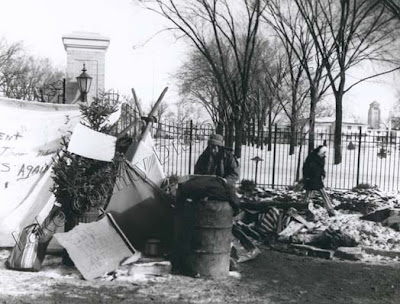Civil War veterans Silas S. Nichols, 145th Ohio (left) and Frederick Worth, 96th Illinois (right), photographed by teacher Lee Riley in May 1918 at Townline School grounds on the northwest corner of Yorkhouse and Delany Road.
Dunn Museum 2011.0.226
Under Colonel Henry C. Ashwell, the 145th Ohio immediately proceeded to Washington, D.C. where it performed garrison duty. In July 1864, when Confederate General Early threatened Washington, the Regiment was constantly under arms. It mustered out on August 23, 1864.
While in D.C. with the regiment, Nichols saw President Lincoln three times. On one occasion, Nichols and several fellow soldiers called on the President at the White House. Lincoln came to his office door to welcome them and shook Nichols' hand.
In 1873, Nichols married Elizabeth C. Helrick (1857 - 1945) in Milan, Ohio. The couple moved to Lake Villa in 1889. In 1892, they moved to Waukegan where Nichols worked for the Elgin, Joliet & Eastern Railroad as a railroad detective. He remained "special police" for the EJ & E until his retirement in 1920.
Silas and Elizabeth Nichols lived at 506 Poplar Street
in Waukegan from circa 1905 to 1945. The house was built in 1901. Google Maps.
On each Memorial Day from 1925 to 1942, Nichols recited the Gettysburg Address at the service in the Waukegan courthouse square. He continued to attend the memorial service, placing a wreath at the Soldiers and Sailors Monument until 1944. Nichols also participated in the procession of "boys in blue" each year in Chicago on Michigan Avenue.
Mrs. Lucile McGaughey pinning an American Legion poppy on the lapel of Silas Nichols while George Groat (left) of the Homer Dahringer Post observes. Waukegan News Sun, 1939.
On Memorial Day 1944, Silas Nichols (right) placed a wreath
at the Soldiers and Sailors Monument in the courthouse square,
Waukegan. Dunn Museum 94.34.278
Silas and Elizabeth Nichols were married for 71 years. They were feted as the longest married couple in Lake County. They credited their happy marriage to "independence for both husband and wife and plenty of give and take."
Silas and Elizabeth Nichols on their 70th wedding anniversary.
Chicago Tribune, March 7, 1943.
While Silas was active in the Grand Army of the Republic as commander of the Waukegan post and judge advocate of the Illinois GAR, Elizabeth devoted herself to the GAR's Women's Relief Corps.
Each time a Civil War veteran passed away it made the papers. The Chicago Tribune was one of many area newspapers that covered Nichols' death on January 10, 1945.
In 1953, the last verified combat veteran of the Civil War, James A. Hard (1843 - 1953) died; and drummer boy Albert Woolson (1847 - 1956) was the last veteran of the Civil War. After Woolson's death the Grand Army of the Republic was dissolved, since he was its last member. At least three men died after Woolson claiming to be Confederate veterans, but their status was debunked.
In 1945, the Women's Relief Corps applied for a military headstone for Nichols.
The application (above) was approved by the Adjutant General of Illinois. Ancestry.com
Silas Nichols' tombstone at Hickory Union Cemetery,
Edwards Road, Antioch Township, Lake County, IL.
Findagrave.com
Carved at the bottom of Silas and Elizabeth Nichols' shared tombstone are the words: "He shook the hand of Lincoln."
- Diana Dretske, Curator ddretske@lcfpd.org




















































